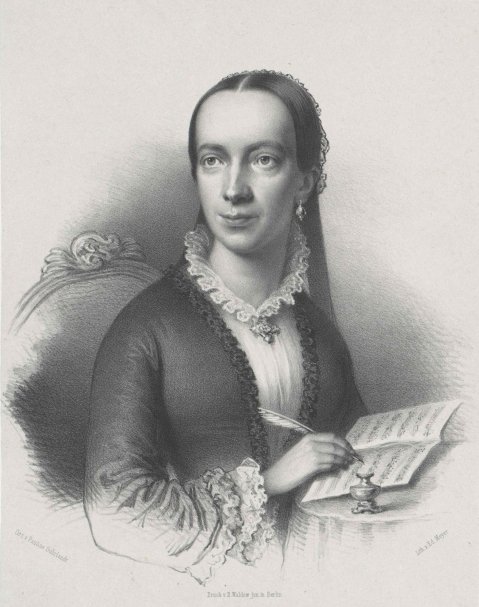For the Australian Romantic & Classical Orchestra, every day is International Women’s Day! We’re a female-led organisation with amazing women musicians, composers, board members and supporters. So we’re celebrating with shoutouts to some badass women composers from the 19th century. If you’re an ARCO fan, you’ll have heard of some we’ve played. Others might be new. All are amazing for pursuing musical success despite resistance from family, male competitors and the times in general. Explore their work on our Spotify playlist.
Louise Farrenc, anonymous artist (Wikimedia Commons)
Louise Farrenc (1804-1878)
Louise Farrenc is one of our favourites – especially her Nonet, which we toured in June 2023. Born in 1804 into a family of French artists, Farrenc was a professional-level pianist as a teenager, and at 15 took composition lessons at the Paris Conservatoire. Louise married fellow student and flautist Aristide Farrenc, touring with him. In 1842 she became Professor of Piano at the Paris Conservatoire – the second-ever women to do so. She composed numerous solo, chamber and orchestral works which were premiered by leading musicians, and her Nonet was so successful she used it to achieve equal pay to her male counterparts at the Conservatoire (go, Louise!!). She continued to perform and teach, but after her death in 1878 her works were overlooked for a century until recently rediscovered as the treasures they are.
Fanny Mendelssohn. Portrait by Wilhelm Hensel (Wikimedia Commons)
Fanny Mendelssohn (1805-1847)
Fanny Mendelssohn Hensel was also an excellent pianist and composer. Born in 1805 (just one year after Farrenc) into a highly musical and intellectual family, she was very close with younger brother Felix both musically and emotionally. Felix didn’t want her to publish her compositions (he felt it unladylike) but she wrote over 450 lyrical pieces (including at least one that was attributed to Felix until very recently).
Fanny also led salons, performing on piano. In 1829 she married artist Wilhelm Hensel and had one child. With Wilhelm’s encouragement, she finally published her Opus One collection of songs. In 1847 Fanny met several times with Clara Schumann, both working on new pieces, but sadly Fanny died of a stroke soon after at age 41. Felix would die of the same cause just six months later.
Emilie Mayer. Lithograph based on a drawing by Pauline Suhrlandt (Wikimedia Commons)
EMILie MAYER (1812-1883)
Emilie Mayer was born in Germany in 1812. She learned piano early on, raised by her father after her mother died when she was two. In 1840 Emilie’s father tragically committed suicide on the anniversary of her mother’s burial, leaving Emilie with a large inheritance. She moved to a local city and then Berlin to study composition, and by 1850 had had several works premiered: symphonies, an overture, a choral work, lieder and piano pieces.
Emilie was also awarded the gold medal of art by the Queen of Prussia, and continued a highly successful composition career, her works played around Europe. She was also a well-regarded sculptor. Very little of her work was published, however, and after her death in 1883 her music went unperformed until very recently.
Clara Schumann. Lithograph by August Kniesel after Cäcilie Brand (Wikimedia Commons)
CLARA SCHUMANN (1819-1896)
Clara Schumann (née Wieck) was born in Germany, soon after Mayer in 1819. An extremely gifted pianist, she was taught by her father, who took her to the best teachers in Germany to study composition. By her teens she was one of Europe’s best pianists, touring extensively and known as the “Queen of the Piano.” But it wasn’t a happy childhood – her father was demanding and abusive. When Clara fell in love with the handsome music student who had moved in to take lessons – Robert Schumann – her father forbade their marriage.
Eventually they wedded, and Clara went on to have a brilliant concert pianist career while supporting eight children, promoting Robert’s compositions and coping with his later mental collapse and death. She became the first and only female teacher at the conservatorium in Frankfurt, teaching until she was 73 and creating a lasting legacy of modern piano technique. She found teaching jobs for her children, and continued to perform until the age of 72. Her compositions range from piano music to lieder (songs) and larger works. Clara died of a stroke aged 76 in 1896.
Amy Beach. Photo: Library of Congress (Wikimedia Commons)
AMY BEACH (1867-1944)
Amy Beach was born in 1867 in the U.S.A. to a distinguished New England family. She was a child prodigy, memorising 40 songs by the age of one, reading at age three and playing four-part hymns by age four. She studied piano with her mother at age six and began giving recitals one year later, including of her own pieces. In 1885 she played her first concert with the Boston Symphony, and also married physician Dr. Henry Harris Aubrey Beach.
Amy’s husband didn’t want her to perform in public, but she didn’t let that stop her musically. Instead, she began composing, teaching herself by studying the great masters and translating European treatises. She was highly successful: the first American woman to have a symphony performed by a major orchestra, with many other instrumental, vocal and choral works. After her husband died in 1910 Amy toured Europe as a performer and composer, to enthusiastic reviews. She continued to perform, compose and teach, holding leadership roles and promoting women composers. Amy’s work reflects her Irish ancestry and New England heritage. She died in 1944.
Florence Price. Photograph: George Nelidoff (Wikimedia Commons)
FLORENCE PRICE (1887-1953)
Florence Price was born in 1887 in Little Rock, Arkansas during the Jim Crow era of extreme racial segregation. Florence learned music from her mother, going on to study composition, piano and organ at the New England Conservatory. After graduating, Florence taught at colleges and universities throughout the American south before moving with her family to Chicaco in 1927 to escape racial conflict and discrimination. She studied composition at the American Conservatory and Chicago Musical College, winning the Wanamaker competition and becoming the first Black woman to have a work performed by a major American orchestra.
Florence kept composing throughout her life: orchestral, instrumental and vocal music reflecting popular and classical styles of the time as well as her Southern heritage. She also kept teaching piano until her death in 1953.
Fanny Mendelssohn, “Das Jahr” (‘The Year’) for piano solo (Manuscript, Wikimedia Commons)








